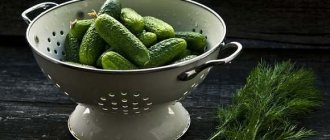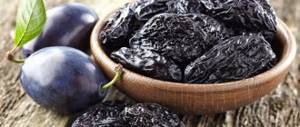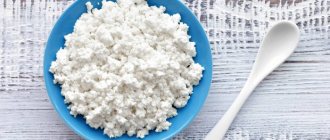Gastritis, chronic and acute, is a disease characterized by an inflammatory process of various etiologies of the gastric mucosa.
The main areas of treatment, in addition to drug therapy, are a special diet. Buckwheat for gastritis and some other types of cereals are prescribed by nutritionists both for gastritis with high acidity and low acidity. Medical nutrition is divided by number depending on the disease for which it is prescribed. In case of an acute attack of gastritis, table No. 1 is prescribed, in case of a chronic form - No. 2. When prescribing, the doctor describes in detail the patient’s regimen, permitted and prohibited foods and dishes.
Composition of buckwheat
Useful properties of the product
Buckwheat porridge is a common side dish, as well as a very nutritious dish rich in vitamins and minerals. Useful properties and components:
- High protein content;
- A large number of microelements (phosphorus, zinc, calcium, magnesium, potassium, iron);
- Content of B vitamins, vitamin PP, A;
- No gluten in the composition;
- Ease of digestion;
- Neutral acidity of the product.
All these properties answer the question of whether buckwheat is good for stomach diseases. This product is very nutritious, contains many substances necessary for the daily diet, is easily digestible, allowing all useful elements to quickly enter the bloodstream.
- Vitamin PP improves the regenerative properties of the mucous membrane;
- Neutral pH reduces acidity;
- Iron is necessary for anemia;
- The lightness of the product is useful, since inflamed mucous membranes require foods that are as easily digestible as possible.
Buckwheat is an indispensable cereal
The Slavs considered buckwheat “ the food of strong men ” and for good reason. Cereals have long been included in the daily diet of the population of our country. Even first courses are prepared from it, and there are also recipes for desserts.
On store shelves, buckwheat is available in the public domain in the form of kernels and prodel, that is, split cereals. Manufacturers also offer buckwheat flakes that are cooked with minimal exposure to temperature.
Buckwheat gained popularity due to its composition and value. Cereals are useful due to the large amount of vitamins B, E, and PP. Porridge in the diet can replenish the amount of microelements and protein a person needs.
Among the mineral substances in its composition, the cereal contains:
- iron;
- copper;
- iodine;
- phosphorus.
On our website: What to do if you really want sweets with gastritis?
Calorie content – 313 kcal per 100g.
Such a product in the diet has a positive effect on human health :
- normalization of cholesterol levels;
- improvement of metabolism;
- prevention of oncology development;
- prevention of thrombosis and diseases associated with the heart and blood vessels;
- normalization of blood sugar levels;
- provides the necessary amount of folic acid.
Thanks to these properties, buckwheat was prescribed to pregnant women, those suffering from diabetes, and obese people.
The buckwheat diet allows you to significantly lose weight without harm to the body..
Features of use
Buckwheat is boiled in water or milk. A popular breakfast was once porridge with milk and sugar. If you cook it in milk, then when consumed, not the entire volume of cereal is digested, which is impractical.
It is useful to eat buckwheat raw to obtain all the components in their original form. To do this, you can soak it in water overnight to soften it. Thus, the body will receive the most beneficial elements from the composition, while the calorie content is lower.
Due to the high protein content, it is not necessary to weigh the dish down with meat. Useful for a low-carb diet when combined with boiled chicken, boiled vegetables or fresh in the form of a salad.
Sample menu for a patient with gastritis
Buckwheat for stomach and duodenal ulcers
Peptic ulcer disease is characterized by damage to the mucous lining of the stomach or duodenum against the background of prolonged inflammation. The main factor provoking the development of the disease is the presence of a pathogenic strain of Helicobacter Pylori in the human body. These bacteria contribute to increased synthesis of hydrochloric acid, imbalance between protective factors (mucus, buffer systems) and aggression.
Against the background of long-term inflammation, crater-shaped defects – ulcers – appear on the mucous lining of the stomach or the initial segment of the small intestine. They can lead to hidden internal bleeding from the gastrointestinal tract, as well as other equally dangerous complications (malignancy, perforation with the development of peritonitis).
In addition to taking antibacterial and antacid medications, it is important to follow a special diet, which necessarily includes cereals. Due to their structure, they perfectly envelop the gastric wall and contain a number of useful trace elements and minerals. Buckwheat porridge is the best choice because it can be used as a side dish, a quick breakfast, and for making soup.
Features of preparing and consuming buckwheat for gastritis
There are many ways to cook buckwheat deliciously; some for weight loss use raw porridge soaked in water overnight, which in some cases is useful, but not for gastritis.
Eating buckwheat with gastritis is possible only under certain cooking conditions:
- Cooking only with water. Avoid cooking with milk;
- For better digestion, you can first grind the cereal;
- Serve warm only;
- Add minimal spices and oil;
- The ratio with water is 1:3.
The beauty of the product is that it can be combined with many products. In the case of gastritis, it is more correct to select the following dishes:
- Boiled chicken breast;
- Steamed cutlets;
- Vegetable stew;
- Canned stewed meat;
- Low-fat baked fish.
You should not add a lot of spices, vegetable oil, butter, or salt to the dish. Fresh vegetables, fried meat and fish are contraindicated.
General recommendations and menu
Cooking buckwheat correctly
To improve the condition of the gastric mucosa and eliminate foci of inflammation, it is necessary to prepare buckwheat correctly. Cereals prepared with milk or kefir will significantly alleviate the patient’s condition and normalize the functioning of the gastrointestinal tract. Skim milk will soothe the inflamed walls of the stomach, and buckwheat will create an enveloping, protective layer.
It is better to treat with uncooked cereals. You need to soak it overnight in advance. Calculate the proportions as follows: for 2 tablespoons of cereal, 200 ml of milk, kefir or water.
This method of preparation is considered the most gentle for erosive gastritis, because all useful microelements are preserved in the product. Also, sprouted buckwheat grains, which are prepared in a similar way, are very useful.
Increased acidity
Hyperacid gastritis is a condition in which gastric juice has too high a pH, causing damage to its own mucous layer. If acidity remains elevated for a long time, then the damage that began with erosion develops until the formation of an ulcer.
Also, with an increased acidic environment, peristalsis is stimulated, which is why patients complain of diarrhea and weight loss.
With this type of gastritis, it is necessary to constantly lower the pH level, this is done with medication and nutrition. Eating alkaline or neutral foods, which are various cereals, helps:
- Pshenka,
- Pearl barley,
- Oatmeal,
- Semolina,
- Millet,
- Rice,
- Corn grits,
- Buckwheat.
It is these porridges that make up the patient’s main diet during an exacerbation.
Type of gastric mucosa with gastritis
Buckwheat for exacerbation of gastritis
During the acute period of the disease, a person often feels severe pain and suffers from vomiting. In the first days, the patient is advised to refuse food, replacing it with rosehip infusion, weak sweetened tea or table water. On the 2-3rd day, you can introduce viscous soups and liquid porridges into the diet, but buckwheat porridge should be viscous, it has an enveloping effect on the inflamed mucous membrane.
Eating any food must be portioned; overeating, including buckwheat porridge, is not allowed. The product is eaten only in grated or highly crushed form.
Low acidity
The peculiarity of the pathogenesis of hypoacid gastritis is that the pH in the stomach is higher than permissible, because of this the necessary enzymes cannot be activated, peristalsis is not activated, and food is retained in the stomach, which leads to the following problems:
- Constipation;
- Feeling of heaviness and discomfort in the abdomen;
- Decreased appetite;
- Dysbacteriosis;
- Hypovitaminosis.
Due to increased rotting of food and the proliferation of bacteria, inflammation develops and the structure of the mucous membrane is disrupted in the same way as with the previous type.
With this type of gastritis, is it possible to eat rice or millet porridge, buckwheat, the question is complex. On the one hand, cereals are an ideal combination of protein- and carbohydrate-rich foods and easily digestible foods, while the acidity does not decrease with their consumption, but only increases. Therefore, porridges are allowed in limited quantities, but only if the pH is increased with the help of medications and acidic foods.
How to properly follow the kefir-buckwheat diet for weight loss and healthier body
Any product can benefit the body only if it is consumed correctly, so when following the kefir-buckwheat diet, the main thing is not to overdo it. There are several ways to follow this principle of nutrition for the purpose of health improvement, as well as weight loss.
Healthy breakfasts
To improve digestion and cleanse the body, it is not necessary to make up your entire daily diet only from buckwheat in combination with kefir; it is enough to consume these products as a hearty and healthy breakfast, which will relieve hunger for a long time and will help normalize digestion throughout the day. If you follow a drinking regime and proper nutrition, limiting the consumption of animal fats and fast carbohydrates, such a diet will contribute to a gradual loss of body weight and consolidation of the achieved results in weight loss. The recommended duration of the body cleansing course is 10 days, after which you should take a break for 3 months. In total, up to three cleanings can be carried out per year.
Related material: How much gluten is in corn?
In order to diversify your breakfasts, you can prepare buckwheat with kefir in various ways, which are presented below, while it is necessary to take into account the characteristics of the body and the presence of chronic diseases, as well as contraindications for certain options for consuming these products.
Fasting days
The effectiveness of the diet does not lie in the number of kilograms lost, but in the duration of maintaining the achieved results. Fasting days are one of the ways to keep your weight within limits, as well as lose extra pounds gained during the holidays or food breakdowns. However, few people manage to control their appetite during the day by drinking only green tea or fruit. In this case, buckwheat with kefir will help, since this combination of products is quite nutritious, while the dishes are low in calories.
Rules for observing fasting days on buckwheat and kefir:
- you should consume no more than 200 g of cereal (meaning the weight of raw buckwheat) and one liter of low-fat kefir per day;
- the dish prepared in advance should be divided into 5–6 servings;
- There should be equal intervals between meals, no more than 3 hours, during which it is allowed to drink green tea without sugar;
- An hour before bedtime, you can drink a glass of kefir at room temperature.
Fasting days on buckwheat and kefir should be carried out systematically: first once a week for 2 months, and then once a month for a year.
Green tea, especially if it is made from fresh leaves of fruit trees, contains a large amount of vitamins
Green tea should be drunk either hot or warm, since cold green tea is poison for the body.
Strict diet
Many sources describe a strict diet on buckwheat and kefir, which involves eating only these products in limited quantities for 4–5 days. Opinions about this method of losing weight are controversial, since nutritionists do not recommend using mono-diets for various reasons.
- A poor diet leads to a deficiency of certain beneficial nutrients, which certainly affects health. With prolonged adherence to a mono-diet, vitamin deficiency is possible, and in special cases, hypervitaminosis (poisoning of the body with toxins due to excessive accumulation of vitamin-like substances).
- A monotonous diet does not contribute to weight loss, as it creates a subconscious desire for satiety. The body, not receiving the necessary substances, gives a hunger signal, and a person may feel hungry even after a meal.
- Such a diet causes stress, which only contributes to a slowdown in metabolism and the accumulation of extra pounds.
- The main result of a strict diet is achieved by removing toxins, unloading the intestines, and also removing excess fluid from the body, because buckwheat helps relieve swelling. Such a diet, used for a short period, is not capable of affecting the amount of subcutaneous and internal fat. As a rule, after returning to the usual way of eating, the scales gradually return to their previous values.
- Long-term consumption of the same foods develops a persistent aversion to them.
Those who decide to try this diet on themselves should listen to the state of their body especially carefully. At the first symptoms of exhaustion, heaviness in the intestines, pain in the stomach, you should stop the diet.
The result of a strict buckwheat-kefir diet is difficult to predict. You will certainly get rid of a large number of problems with the gastrointestinal tract, but the number of kilograms lost depends entirely on your initial weight, the presence of toxins and excess fluid in the body. If you have a normal weight, but you don’t like it, the buckwheat-kefir diet will not help.
Features of the use of buckwheat and kefir for various diseases
To ensure that such a diet does not cause harm, you should know the nuances of preparing buckwheat with kefir, which may differ for various diseases:
- for pancreatitis and gastritis, you should choose only low-fat kefir or a product with 1% calorie content;
- for any diseases of the gastrointestinal tract, you should not prepare a dish by soaking buckwheat in kefir, since the kernels after swelling still remain hard and can cause an exacerbation of the disease;
- to remove toxins, for example, to prevent cancer, it is recommended to choose green varieties of buckwheat, as it contains more antioxidants;
- If you are prone to constipation, you should not choose homemade kefir older than two days, since such a product tends to strengthen, while fresh, one-day old kefir, on the contrary, promotes loose stools. As for store products, they are neutral in this regard;
- for diabetes, preference should be given to 1% kefir of a proven brand. Manufacturers often add starch to low-calorie fermented milk products as a thickener; this should also be taken into account when converting the dish into bread units.
People with various chronic diseases should use buckwheat with kefir for health purposes only after prior consultation with their doctor.
Nutritionist on a diet: all about the buckwheat-kefir diet - video
Buckwheat dishes
Examples of recipes that are used for remission of gastritis, when the symptoms are absent or mild.
- Fry the cereal in a frying pan, this will enrich the aroma, then mix with water in a ratio of 1:2 or 1:3. In the second case, the porridge will turn out softer and juicier. Add salt and pepper to taste and a little olive oil. Cook for about 10-15 minutes over medium heat. When ready, cover with a lid and let sit for 20-30 minutes before serving. This recipe contains minimal calories and carbohydrates.
- Bake buckwheat along with finely chopped onions and carrots, pre-fried without oil. Instead of water, use chicken broth with the addition of 2-3 tablespoons of low-fat sour cream. Place in the oven in a pot with the addition of salt and pepper and dried herbs.
- The recipe for a multicooker is as simple as possible, you need to mix the cereal with water, add a little spices and oil, set it to the “cereals” or “buckwheat” mode, you can gradually add vegetables or meat.
How to treat the stomach with buckwheat? Traditional medicine recipes
Buckwheat porridge should not be considered only as a food product. After all, it is an integral part of traditional treatment recipes.
For example, if you have increased acid production, you should try the following recipe for health purposes. Fry the cereal in a frying pan, but do not add oil. Once it turns brown, let the cereal cool. Then grind. Take a pinch of this powder three times a day shortly before meals.
It is also recommended to consume raw buckwheat on an empty stomach for 14 days. To do this, in the evening, pour a tablespoon with water in a 1:1 ratio. And in the morning it is eaten 30 minutes before breakfast.
Thus, buckwheat porridge can and should be included in the diet for diseases of the stomach and intestines, as well as for improving the health of the body. At the same time, do not forget to add variety to your diet and follow all doctor’s instructions.
Gastritis with high acidity
What porridges can be used for gastritis with high acidity, which ones are healthy, and which ones should be consumed in limited quantities:
- Buckwheat, millet, oatmeal, millet, barley and rice, all cereals are allowed, as they reduce and neutralize acid in the stomach.
- You can add butter or vegetable oil, but in small quantities;
- It is forbidden to add onions, garlic, mushrooms, or tomatoes to the porridge.
It is important to properly combine prescribed medications with food in order to achieve their desired effect. It is also important to eat 5-6 meals a day in small portions, and not eat 3-4 hours before bedtime.
Classification
Is it possible to eat buckwheat if you have gastritis?
Buckwheat porridge is used for both types of gastritis with low or high pH (acidity) of the stomach. In this case, only the method of its preparation changes. Even despite the benefits of cereals and a lot of useful properties, you should contact a gastroenterologist for menu recommendations. He will establish the permissible amount of buckwheat consumption based on the clinical picture of the development of gastritis. Side dishes are prepared from it and combined with vegetables or lean meat.
For low acidity
With hypoacid gastritis, the body does not contain enough enzymes to process food. Therefore, the menu includes dishes that stimulate the secretion of gastric juice and do not irritate the gastric mucosa. Cooked buckwheat should be crumbly and viscous. The preparation time for this side dish is a little longer than usual, but this way it retains its beneficial properties and does not harm the digestive system. Hypoacid gastritis allows you to introduce mushrooms into the diet, on the basis of which buckwheat soup with vegetables and meat is prepared, or served as an addition to porridge. The buckwheat itself is seasoned with sesame or your favorite vegetable oil and a little cream is added.
With high acidity
Increased pH requires avoiding fatty foods. Therefore, it is recommended to prepare buckwheat soup in vegetable broth, without meat and with vegetable oil. Porridge is cooked in water, but you can also eat buckwheat with milk. Portions should be small but frequent. Don't let your stomach feel heavy. The cereal is boiled or steamed for gastritis with an increased pH of the stomach in combination with poultry, rabbit or veal meat.
Gastritis with low acidity
In the case of hypoacidity, it is important to follow the rule - no cooking with milk. The alkaline pH of dairy products not only reduces the availability of grains, but also stops the progress of the food bolus, which leads to symptoms characteristic of low acid gastritis.
Oatmeal, semolina, wheat and rice porridge with milk are prohibited, all exclusively with water. You should not eat cereal in the morning with milk or drink hot milk with honey before bed if you are sick.
It is important to add vegetables such as onions, carrots, mushrooms to porridges, do not be shy about drinking tea with lemon, making sour borscht, in reasonable quantities, of course.
The details of the diet are spelled out in the characteristics of therapeutic diets; any questions that concern you should be asked during a consultation with your doctor or nutritionist.










